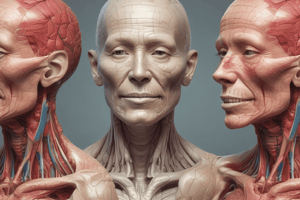Podcast
Questions and Answers
ما الجهة التي تعني الجزء الأقرب إلى الوسط؟
ما الجهة التي تعني الجزء الأقرب إلى الوسط؟
- العلوية
- السفلية
- الأمامية (correct)
- الخلفية
ما المصطلح المستخدم لوصف الجزء الأبعد عن الوسط؟
ما المصطلح المستخدم لوصف الجزء الأبعد عن الوسط؟
- الأمامية
- الخلفية (correct)
- السفلية
- العلوية
أين توجد الوريدة التي تحمل الدم من الرأس والطرفين العلويين إلى القلب؟
أين توجد الوريدة التي تحمل الدم من الرأس والطرفين العلويين إلى القلب؟
- وريدة رئيسية علوية (correct)
- وريدة باطنية سفلى
- وريدة فخذ
- وريدة كاحل
ما المصطلح المستخدم لوصف الجزء الأقرب إلى نقطة أصل جزء من الجسم؟
ما المصطلح المستخدم لوصف الجزء الأقرب إلى نقطة أصل جزء من الجسم؟
أين تنتهي عظمة الفخذ التي تربطها بالعظم الحوضي؟
أين تنتهي عظمة الفخذ التي تربطها بالعظم الحوضي؟
ما المصطلح المستخدم لوصف الجزء الأقرب إلى خط الوسط في جسم الإنسان؟
ما المصطلح المستخدم لوصف الجزء الأقرب إلى خط الوسط في جسم الإنسان؟
ما هي الكلمة التي تستخدم لوصف الجزء الذي يكون في الجانب الخلفي من الجسم؟
ما هي الكلمة التي تستخدم لوصف الجزء الذي يكون في الجانب الخلفي من الجسم؟
ما هي الكلمة التي تستخدم لوصف الجزء الذي يكون في الجهة العلوية من الجسم؟
ما هي الكلمة التي تستخدم لوصف الجزء الذي يكون في الجهة العلوية من الجسم؟
ما هي الكلمة التي تستخدم لوصف الجزء الذي يكون في الجهة السفلى من الجسم؟
ما هي الكلمة التي تستخدم لوصف الجزء الذي يكون في الجهة السفلى من الجسم؟
ما هي الكلمة التي تستخدم لوصف جانب المنطقة وسطية بالنسبة لها؟
ما هي الكلمة التي تستخدم لوصف جانب المنطقة وسطية بالنسبة لها؟
ما هي الكلمة التي تستخدم لوصف المكان الذي يكون فيه جزء من الجسم بجانب آخر؟
ما هي الكلمة التي تستخدم لوصف المكان الذي يكون فيه جزء من الجسم بجانب آخر؟
ما هي الكلمة التي تستخدم لوصف المكان الذي يكون فيه جزء من الجسم بشكل متوازٍ مع خط أساسي؟
ما هي الكلمة التي تستخدم لوصف المكان الذي يكون فيه جزء من الجسم بشكل متوازٍ مع خط أساسي؟
Flashcards are hidden until you start studying
Study Notes
Anatomical Directional Terms: An Overview of Anterior, Posterior, Superior, Inferior, Medial, and Lateral
Introduction
In the field of anatomy, understanding the spatial relationships between different structures is crucial. This is where anatomical directional terms come in handy. These terms are used to describe the positions of structures in relation to each other, making it easier to understand and communicate complex anatomical information. The main directional terms include anterior, posterior, superior, inferior, medial, and lateral.
Anterior and Posterior
Anterior and posterior are terms used to describe the positions of structures in relation to the front and back of the body, respectively. The term "anterior" refers to the front of the body, while "posterior" refers to the back. For example, the anterior surface of the knee is the side that faces forward when the person is standing, while the posterior surface is the side that faces backward.
Superior and Inferior
Superior and inferior are terms used to describe the positions of structures in relation to the head and feet of the body, respectively. The term "superior" refers to the upper or higher part of the body, including the head, while "inferior" refers to the lower or lower part of the body, including the feet. For example, the superior vena cava is the vein that carries blood from the head and upper limbs to the heart, while the inferior vena cava is the vein that carries blood from the lower limbs and lower body to the heart.
Medial and Lateral
Medial and lateral are terms used to describe the positions of structures in relation to the midline of the body. The term "medial" refers to the side of the body that is closer to the midline, while "lateral" refers to the side of the body that is farther from the midline. For example, the medial side of the thigh is the side that faces the midline of the body, while the lateral side of the thigh is the side that faces outward.
Proximal and Distal
Proximal and distal are terms used to describe the positions of structures in relation to the trunk or point of origin of a body part. The term "proximal" refers to the part of the body that is closer to the trunk or point of origin, while "distal" refers to the part of the body that is farther from the trunk or point of origin. For example, the proximal end of the femur is the end that joins the pelvic bone, while the distal end of the femur is the end that forms the knee joint.
Conclusion
Understanding these anatomical directional terms is essential for anyone studying anatomy, as they provide a standardized way to describe the positions of structures in the body. By learning and using these terms, we can communicate complex anatomical information more accurately and efficiently.
Studying That Suits You
Use AI to generate personalized quizzes and flashcards to suit your learning preferences.




